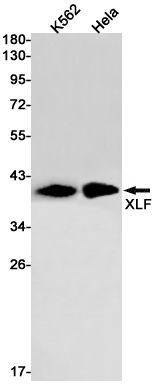XLF Rabbit mAb
- 产品详情
- 实验流程
Application
| WB |
|---|---|
| Primary Accession | Q9H9Q4 |
| Reactivity | Human, Mouse, Rat |
| Host | Rabbit |
| Clonality | Monoclonal Antibody |
| Calculated MW | 33337 Da |
| Gene ID | 79840 |
|---|---|
| Other Names | NHEJ1 |
| Dilution | WB~~1/500-1/1000 |
| Format | 50mM Tris-Glycine(pH 7.4), 0.15M NaCl, 40%Glycerol, 0.01% sodium azide and 0.05% BSA. |
| Storage | Store at 4°C short term. Aliquot and store at -20°C long term. Avoid freeze/thaw cycles. |
| Name | NHEJ1 {ECO:0000303|PubMed:17191205, ECO:0000312|HGNC:HGNC:25737} |
|---|---|
| Function | DNA repair protein involved in DNA non-homologous end joining (NHEJ); it is required for double-strand break (DSB) repair and V(D)J recombination and is also involved in telomere maintenance (PubMed:16439204, PubMed:16439205, PubMed:17317666, PubMed:17470781, PubMed:17717001, PubMed:18158905, PubMed:18644470, PubMed:20558749, PubMed:26100018, PubMed:28369633). Plays a key role in NHEJ by promoting the ligation of various mismatched and non-cohesive ends (PubMed:17470781, PubMed:17717001, PubMed:19056826). Together with PAXX, collaborates with DNA polymerase lambda (POLL) to promote joining of non-cohesive DNA ends (PubMed:25670504, PubMed:30250067). May act in concert with XRCC5-XRCC6 (Ku) to stimulate XRCC4-mediated joining of blunt ends and several types of mismatched ends that are non- complementary or partially complementary (PubMed:16439204, PubMed:16439205, PubMed:17317666, PubMed:17470781). In some studies, has been shown to associate with XRCC4 to form alternating helical filaments that bridge DNA and act like a bandage, holding together the broken DNA until it is repaired (PubMed:21768349, PubMed:21775435, PubMed:22228831, PubMed:22287571, PubMed:26100018, PubMed:27437582, PubMed:28500754). Alternatively, it has also been shown that rather than forming filaments, a single NHEJ1 dimer interacts through both head domains with XRCC4 to promote the close alignment of DNA ends (By similarity). The XRCC4-NHEJ1/XLF subcomplex binds to the DNA fragments of a DSB in a highly diffusive manner and robustly bridges two independent DNA molecules, holding the broken DNA fragments in close proximity to one other (PubMed:27437582, PubMed:28500754). The mobility of the bridges ensures that the ends remain accessible for further processing by other repair factors (PubMed:27437582). Binds DNA in a length-dependent manner (PubMed:17317666, PubMed:18158905). |
| Cellular Location | Nucleus. Chromosome. Note=Localizes to site of double-strand breaks; recruitment is dependent on XRCC5-XRCC6 (Ku) heterodimer |
| Tissue Location | Ubiquitously expressed. |
Research Areas
For Research Use Only. Not For Use In Diagnostic Procedures.
Application Protocols
Provided below are standard protocols that you may find useful for product applications.
终于等到您。ABCEPTA(百远生物)抗体产品。
点击下方“我要评价 ”按钮提交您的反馈信息,您的反馈和评价是我们最宝贵的财富之一,
我们将在1-3个工作日内处理您的反馈信息。
如有疑问,联系:0512-88856768 tech-china@abcepta.com.
¥ 1,500.00
Cat# AP76264























 癌症的基本特征包括细胞增殖、血管生成、迁移、凋亡逃避机制和细胞永生等。找到癌症发生过程中这些通路的关键标记物和对应的抗体用于检测至关重要。
癌症的基本特征包括细胞增殖、血管生成、迁移、凋亡逃避机制和细胞永生等。找到癌症发生过程中这些通路的关键标记物和对应的抗体用于检测至关重要。 为您推荐一个泛素化位点预测神器——泛素化分析工具,可以为您的蛋白的泛素化位点作出预测和评分。
为您推荐一个泛素化位点预测神器——泛素化分析工具,可以为您的蛋白的泛素化位点作出预测和评分。 细胞自噬受体图形绘图工具为你的蛋白的细胞受体结合位点作出预测和评分,识别结合到自噬通路中的蛋白是非常重要的,便于让我们理解自噬在正常生理、病理过程中的作用,如发育、细胞分化、神经退化性疾病、压力条件下、感染和癌症。
细胞自噬受体图形绘图工具为你的蛋白的细胞受体结合位点作出预测和评分,识别结合到自噬通路中的蛋白是非常重要的,便于让我们理解自噬在正常生理、病理过程中的作用,如发育、细胞分化、神经退化性疾病、压力条件下、感染和癌症。






